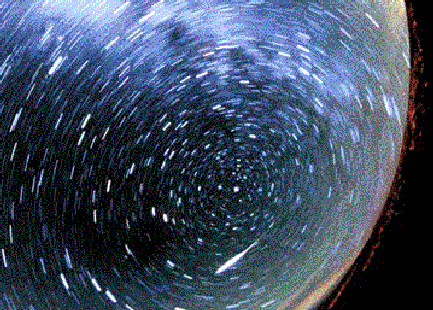
|
Credit & Copyright: V. Winter (ICSTARS)
Explanation:
Early next week, a spectacular meteor storm is expected: the 1998
Leonids.
It is widely thought that that the meteors from the
Leonids meteor shower
are just small pieces of
Comet Temple-Tuttle
falling to Earth. During each pass near the Sun, a comet will
heat up and shed pieces of ice and rock
from its nucleus. This debris
continues to orbit the Sun until
either evaporating or being swept up by
some large solar-system body.
A piece of comet debris striking the Moon
creates a small crater, but a piece striking the Earth usually
burns up in the atmosphere causing
a brief, bright
streak.
The streak below center in the above picture of
the northern sky actually depicts a meteor from
the
Perseid meteor shower,
a usually impressive display that peaks every year in
mid-August.
|
January February March April May June July August September October November December |
| |||||||||||||||||||||||||||||||||||||||||||||||||||||||
NASA Web Site Statements, Warnings, and Disclaimers
NASA Official: Jay Norris. Specific rights apply.
A service of: LHEA at NASA / GSFC
& Michigan Tech. U.
Based on Astronomy Picture
Of the Day
Publications with keywords: Leonids - meteor - meteor shower
Publications with words: Leonids - meteor - meteor shower
See also:
- APOD: 2025 August 25 Á The Meteor and the Star Cluster
- APOD: 2025 August 6 Á Meteor before Galaxy
- APOD: 2024 December 10 Á The Great Meteor Storm of 1833
- APOD: 2024 November 27 Á The Meteor and the Comet
- Meteor over the Bay of Naples
- Quadrantids of the North
- APOD: 2023 December 17 Á Geminids over Chinas Nianhu Lake
